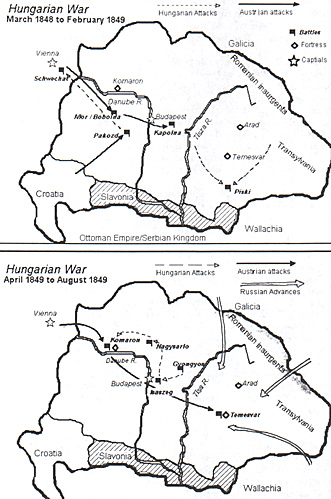 The Forgotten War
The Forgotten War
"The Hungarian army, marching from success to success, is now approaching the Imperial capital."
- --General Artur Gorgei Upper Danubian Army, April 16th, 1849
It was the third largest war on the European continent between 1815 and 1914, involving five nations and over half a million men. The war caused more military and civilian casualties than the Crimean and Franco-Austrian Wars put together. Both Austria and Russia would suffer the political consequences from the Crimean to the Russo-Turkish War of 1877.
The Hungarian war is a fascinating history of brilliant campaigns, colorful uniforms, battles large and small, as well as vicious guerrilla warfare. The war saw such modern innovations as squad tactics develop on the battlefield while remaining boldly Napoleonic in nature. There were smashing cavalry charges, grand batteries, and desperate infantry assaults. Unlike most wars of the 19th Century, scores of engagements involving 10,000 or more men were fought during the year and a half of war, including ten major battles involving over 75,000.
Thousands of exiled veterans of the Hungarian Honved Army would later fight with the Union armies of the Civil War. Flags flown during the Hungarian conflict were carried into battle in 1861 by Union regiments such as the 39th New York. In fact, the Hungarians saw the American Revolution as the inspiration for their struggle, including in their demands to Austria the right to raise local militias.
Americans saw Hungary as only one of two real republics on the continent, calling the exiled leader of the Hungarian revolt, Lajos Kossuth, "the Hungarian George Washington." In 1851, he became only the second foreigner to ever address the U.S. Congress. Many states also honored him. For instance, Kossuth County, Iowa is named after him. The February 9, 1850 Resolution of the Ohio General Assembly reflects the thinking of Americans at the time. It recounts the events of the Hungarian Revolution, stating that:
- "Hungary declared herself to be independent of the Imperial House of Hapsburgh (sic) after twice driving its enemies beyond their borders, positively securing their independence. The Hungarians would have done so, had it not been for the treachery of the Emperor of Russia ... by which Hungary was defeated--That it is well known that Louis Kossuth was a leading man of Hungary, who threw himself his property, his family, his friends, his future hopes and prospects unreservedly and magnanimously into the scale, to secure the freedom of his native land."
Yet, American wargamers know little about this dynamic war, much less game it. Smaller conflicts like the Crimean, Mexican-American war, Russo-Turkish war, Spain's Carlist conflict, Belgian war of the 1830's, and even the South American wars all have their adherents. But wargamers have totally ignored the Hungarian conflict. A profound lack of information has been one cause. The purpose of these articles is to provide enough military history, OOB information and uniform descriptions for interested wargamers to enjoy this multi-faceted war.
More Hungarian War of Independence 1848-1849
-
Introduction
The Hungarian Revolution
Army Organization: Austrian Imperial
Army Organization: Honved
Army Organization: Russian
Hungarian Army 1848-49: Uniforms
Hungarian Army 1848-49: Battle Flags
Hungarian Army 1848-49: Figure Availability
References
Back to MWAN # 120 Table of Contents
Back to MWAN List of Issues
Back to MagWeb Magazine List
© Copyright 2002 Hal Thinglum
This article appears in MagWeb (Magazine Web) on the Internet World Wide Web.
Other military history articles and gaming articles are available at http://www.magweb.com